吴恩达机器学习作业1(单变量与多变量线性回归)
线性回归作业一.回顾线性回归知识点二.作业实战【1】导入需要的包【2】导入数据集并查看【3】使用梯度下降【4】变量初始化batch gradient decent(批量梯度下降)绘制线性模型以及数据,直观地看出它的拟合多变量线性回归一.回顾线性回归知识点二.作业实战【1】导入需要的包import numpy as npimport pandas as pdimport matplotlib.pyp
线性回归作业
一.回顾线性回归知识点
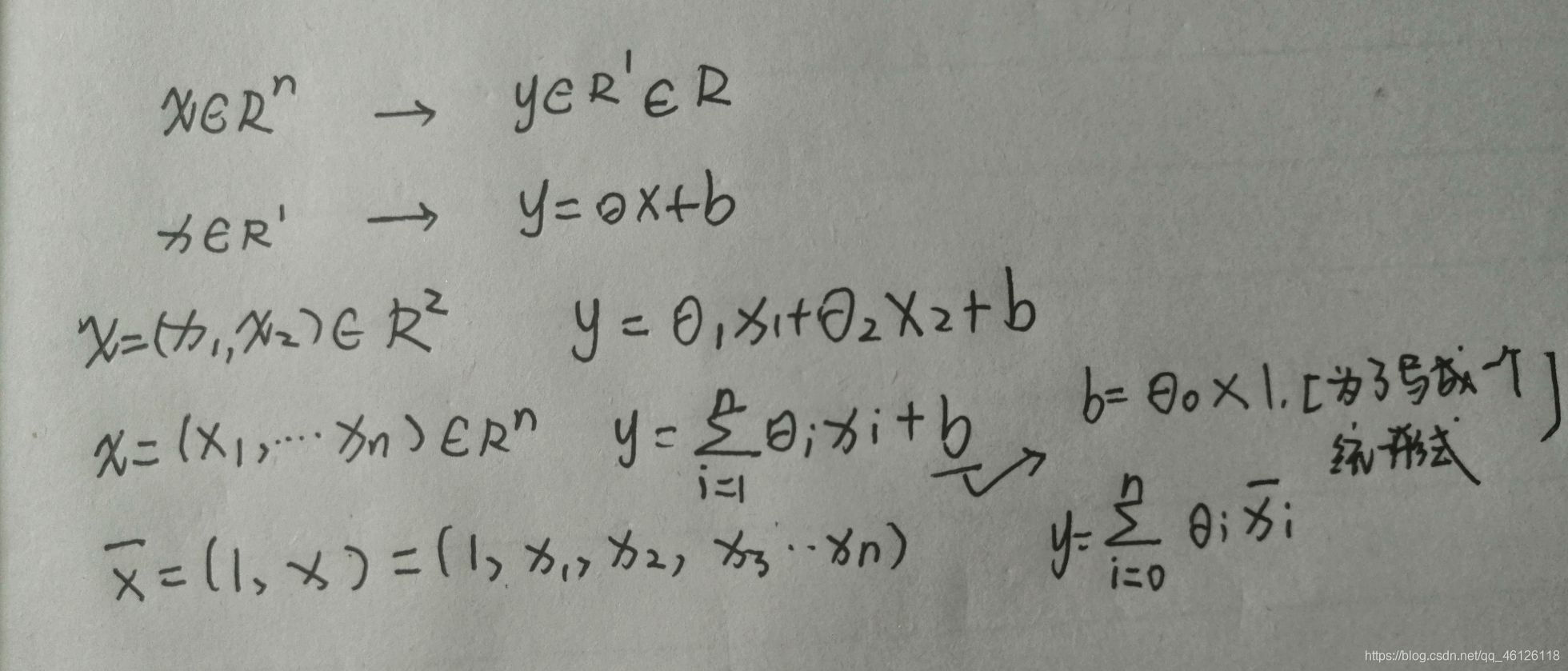
二.作业实战
一.单变量的线性回归
【1】导入需要的包
import numpy as np
import pandas as pd
import matplotlib.pyplot as plt

【2】导入数据集并查看
一定要把数据集和程序放在同一个文件夹里面,
path = 'ex1data1.txt'
data = pd.read_csv(path, header=None, names=['Population', 'Profit'])
data.head()

对于数值数据,结果的索引包括技术,平均值,标准差,最小值,最大值以及较低的百分位数和,默认情况下,较低百分位数为25,较高爆分位数为75,50百分位数和中位数相同
data.describe()data.describe()
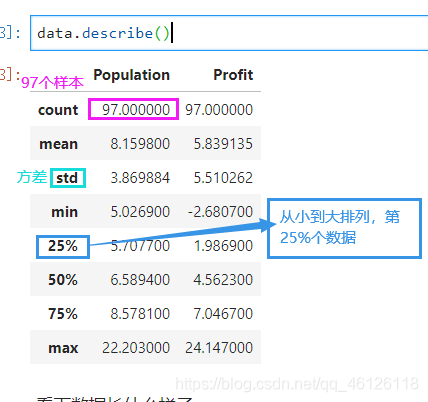
数据可视化,绘制散点图
data.plot(kind='scatter', x='Population', y='Profit', figsize=(12,8))
plt.show()
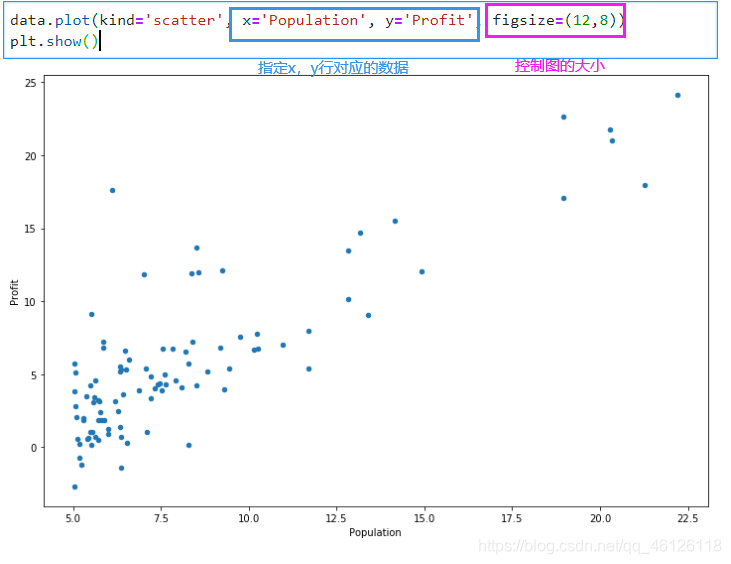
【3】使用梯度下降
现在让我们使用梯度下降来实现线性回归,以最小化成本函数
首先,我们将创建一个以参数θ为特征函数的代价函数
J ( θ ) = 1 2 m ∑ i = 1 m ( h θ ( x ( i ) ) − y ( i ) ) 2 J\left( \theta \right)=\frac{1}{2m}\sum\limits_{i=1}^{m}{{{\left( {{h}_{\theta }}\left( {{x}^{(i)}} \right)-{{y}^{(i)}} \right)}^{2}}} J(θ)=2m1i=1∑m(hθ(x(i))−y(i))2
其中: h θ ( x ) = θ T X = θ 0 x 0 + θ 1 x 1 + θ 2 x 2 + . . . + θ n x n {{h}_{\theta }}\left( x \right)={{\theta }^{T}}X={{\theta }_{0}}{{x}_{0}}+{{\theta }_{1}}{{x}_{1}}+{{\theta }_{2}}{{x}_{2}}+...+{{\theta }_{n}}{{x}_{n}} hθ(x)=θTX=θ0x0+θ1x1+θ2x2+...+θnxn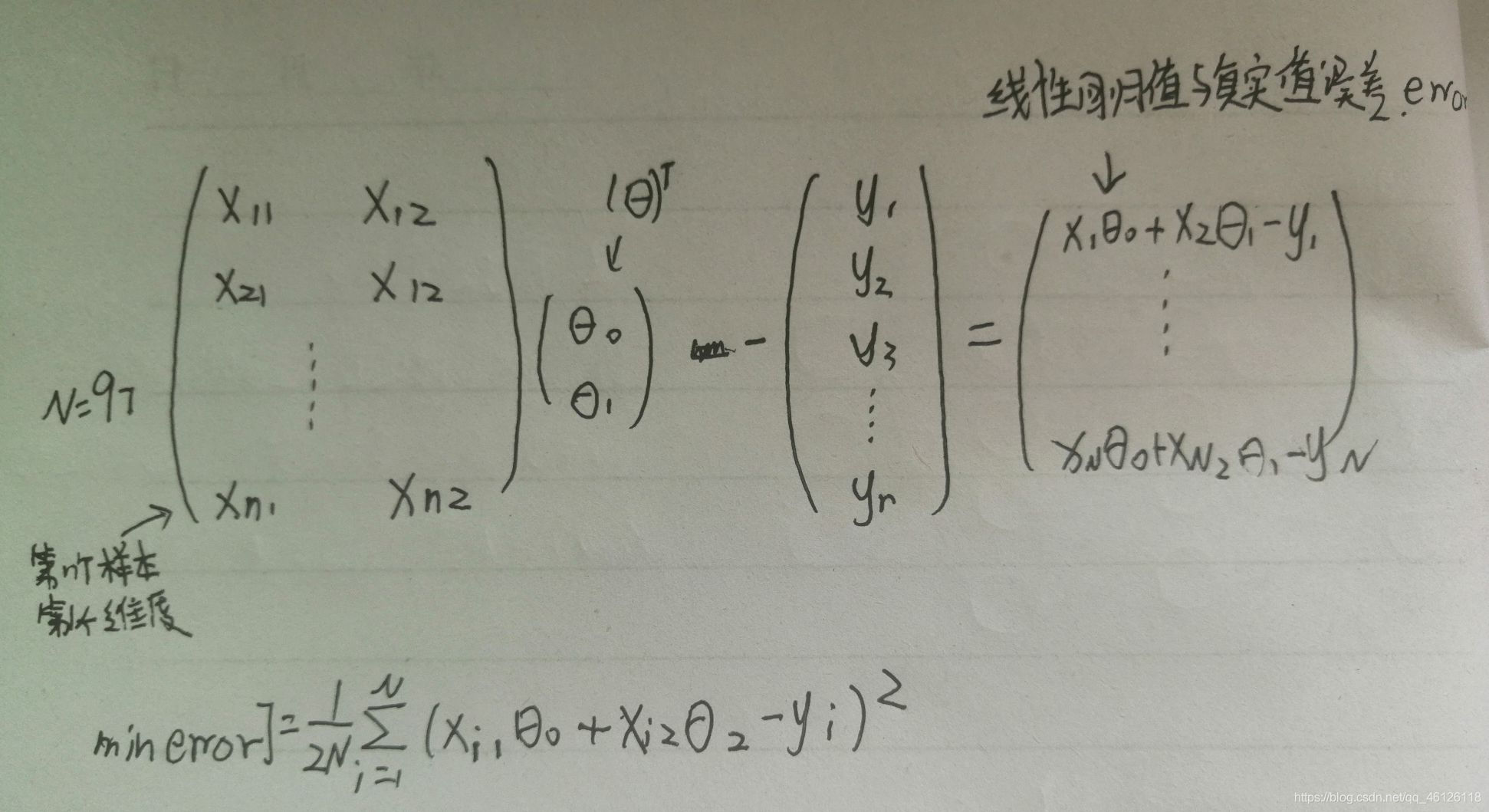
def computeCost(X, y, theta):
inner = np.power(((X * theta.T) - y), 2)
return np.sum(inner) / (2 * len(X))
np.power——就是如果后面跟一个矩阵,和数字,用逗号隔开,那么就把矩阵每一项(数字)方
让我们在训练集中添加一列,以便我们可以使用向量化的解决方案来计算代价和梯度
data.insert(0, 'Ones', 1)
【4】变量初始化
# set X (training data) and y (target variable)
cols = data.shape[1]
X = data.iloc[:,0:cols-1]#X是所有行,去掉最后一列
y = data.iloc[:,cols-1:cols]#X是所有行,最后一列
观察下 X (训练集) and y (目标变量)是否正确.
X.head()#head()是观察前5行
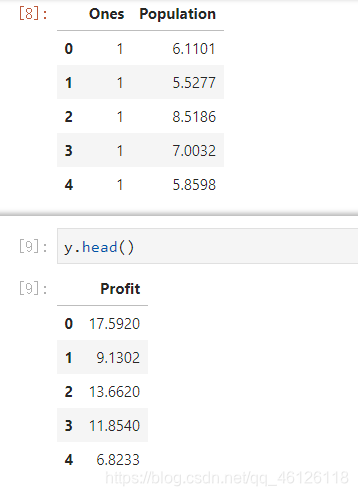
代价函数是应该是numpy矩阵,所以我们需要转换X和Y,然后才能使用它们。 我们还需要初始化theta。
X = np.matrix(X.values)
y = np.matrix(y.values)
theta = np.matrix(np.array([0,0]))
theta 是一个(1,2)矩阵
theta
matrix([[0, 0]])
看下维度
X.shape, theta.shape, y.shape
计算代价函数 (theta初始值为0).
调用这个函数输出
computeCost(X, y, theta)
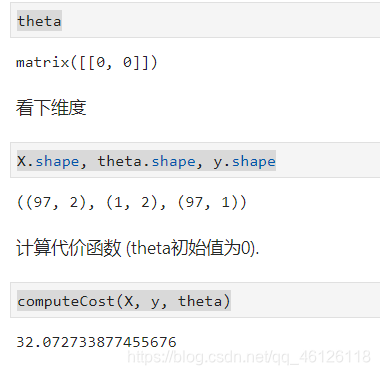
【5】batch gradient decent(批量梯度下降)
θ j : = θ j − α ∂ ∂ θ j J ( θ ) {{\theta }_{j}}:={{\theta }_{j}}-\alpha \frac{\partial }{\partial {{\theta }_{j}}}J\left( \theta \right) θj:=θj−α∂θj∂J(θ)
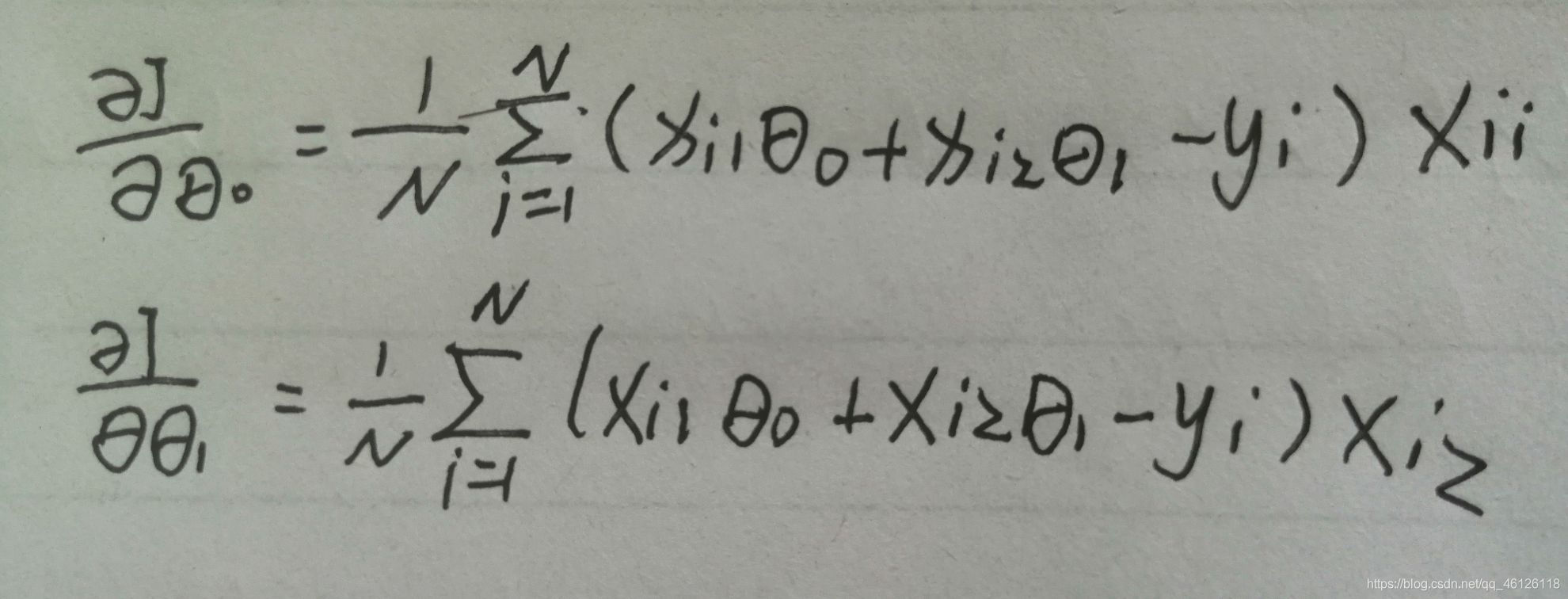
def gradientDescent(X, y, theta, alpha, iters):
temp = np.matrix(np.zeros(theta.shape))
parameters = int(theta.ravel().shape[1])
cost = np.zeros(iters)
for i in range(iters):
error = (X * theta.T) - y
for j in range(parameters):
term = np.multiply(error, X[:,j])
temp[0,j] = theta[0,j] - ((alpha / len(X)) * np.sum(term))
theta = temp
cost[i] = computeCost(X, y, theta)
return theta, cost
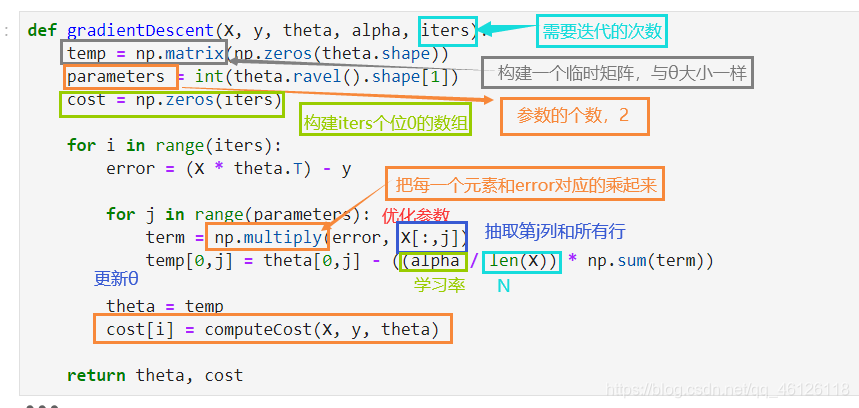
初始化一些附加变量 - 学习速率α和要执行的迭代次数。
alpha = 0.01
iters = 1000
现在让我们运行梯度下降算法来将我们的参数θ适合于训练集。
g, cost = gradientDescent(X, y, theta, alpha, iters)
g
最后,我们可以使用我们拟合的参数计算训练模型的代价函数(误差)
computeCost(X, y, g)

【6】绘制线性模型以及数据,直观地看出它的拟合
x = np.linspace(data.Population.min(), data.Population.max(), 100)
f = g[0, 0] + (g[0, 1] * x)
fig, ax = plt.subplots(figsize=(12,8))
ax.plot(x, f, 'r', label='Prediction')
ax.scatter(data.Population, data.Profit, label='Traning Data')
ax.legend(loc=2)
ax.set_xlabel('Population')
ax.set_ylabel('Profit')
ax.set_title('Predicted Profit vs. Population Size')
plt.show()
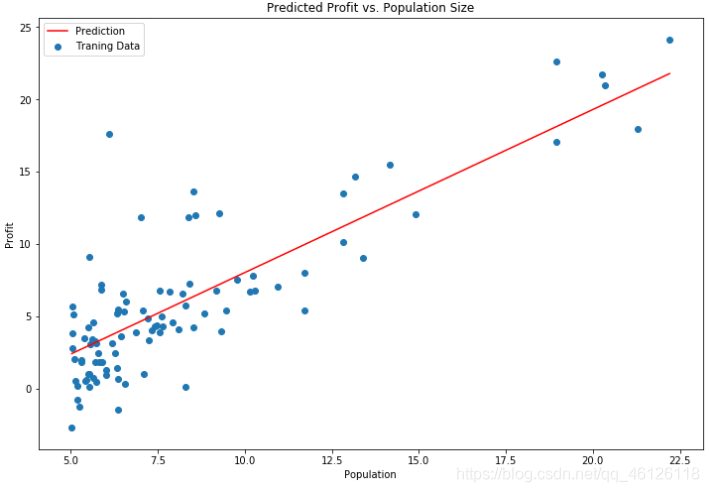

由于梯度方程式函数也在每个训练迭代中输出一个代价的向量,所以我们也可以绘制。 请注意,代价总是降低 - 这是凸优化问题的一个例子。
fig, ax = plt.subplots(figsize=(12,8))
ax.plot(np.arange(iters), cost, 'r')
ax.set_xlabel('Iterations')
ax.set_ylabel('Cost')
ax.set_title('Error vs. Training Epoch')
plt.show()

迭代次数越来越多,越来越收敛
二.多变量线性回归

path = 'ex1data2.txt'
data2 = pd.read_csv(path, header=None, names=['Size', 'Bedrooms', 'Price'])
data2.head()
添加了另一个预处理步骤 - 特征归一化。
data2 = (data2 - data2.mean()) / data2.std()
data2.head()

现在我们重复第1部分的预处理步骤,并对新数据集运行线性回归程序
# add ones column
data2.insert(0, 'Ones', 1)
# set X (training data) and y (target variable)
cols = data2.shape[1]
X2 = data2.iloc[:,0:cols-1]
y2 = data2.iloc[:,cols-1:cols]
# convert to matrices and initialize theta
X2 = np.matrix(X2.values)
y2 = np.matrix(y2.values)
theta2 = np.matrix(np.array([0,0,0]))
# perform linear regression on the data set
g2, cost2 = gradientDescent(X2, y2, theta2, alpha, iters)
# get the cost (error) of the model
computeCost(X2, y2, g2)
0.13070336960771892
快速查看训练进程。
fig, ax = plt.subplots(figsize=(12,8))
ax.plot(np.arange(iters), cost2, 'r')
ax.set_xlabel('Iterations')
ax.set_ylabel('Cost')
ax.set_title('Error vs. Training Epoch')
plt.show()

scikit-learn model的预测表现
我们也可以使用scikit-learn的线性回归函数,而不是从头开始实现这些算法。 我们将scikit-learn的线性回归算法应用于第1部分的数据,并看看它的表现
from sklearn import linear_model
model = linear_model.LinearRegression()
model.fit(X, y)
LinearRegression(copy_X=True, fit_intercept=True, n_jobs=None, normalize=False)
x = np.array(X[:, 1].A1)
f = model.predict(X).flatten()
fig, ax = plt.subplots(figsize=(12,8))
ax.plot(x, f, 'r', label='Prediction')
ax.scatter(data.Population, data.Profit, label='Traning Data')
ax.legend(loc=2)
ax.set_xlabel('Population')
ax.set_ylabel('Profit')
ax.set_title('Predicted Profit vs. Population Size')
plt.show()
三. normal equation(正规方程)
正规方程是通过求解下面的方程来找出使得代价函数最小的参数的: ∂ ∂ θ j J ( θ j ) = 0 \frac{\partial }{\partial {{\theta }_{j}}}J\left( {{\theta }_{j}} \right)=0 ∂θj∂J(θj)=0 。
假设我们的训练集特征矩阵为 X(包含了 x 0 = 1 {{x}_{0}}=1 x0=1)并且我们的训练集结果为向量 y,则利用正规方程解出向量 θ = ( X T X ) − 1 X T y \theta ={{\left( {{X}^{T}}X \right)}^{-1}}{{X}^{T}}y θ=(XTX)−1XTy 。
上标T代表矩阵转置,上标-1 代表矩阵的逆。设矩阵 A = X T X A={{X}^{T}}X A=XTX,则: ( X T X ) − 1 = A − 1 {{\left( {{X}^{T}}X \right)}^{-1}}={{A}^{-1}} (XTX)−1=A−1
梯度下降与正规方程的比较:
梯度下降:需要选择学习率α,需要多次迭代,当特征数量n大时也能较好适用,适用于各种类型的模型
正规方程:不需要选择学习率α,一次计算得出,需要计算 ( X T X ) − 1 {{\left( {{X}^{T}}X \right)}^{-1}} (XTX)−1,如果特征数量n较大则运算代价大,因为矩阵逆的计算时间复杂度为 O ( n 3 ) O(n3) O(n3),通常来说当 n n n小于10000 时还是可以接受的,只适用于线性模型,不适合逻辑回归模型等其他模型
正规方程
def normalEqn(X, y):
theta = np.linalg.inv(X.T@X)@X.T@y#X.T@X等价于X.T.dot(X)
return theta
final_theta2=normalEqn(X, y)#感觉和批量梯度下降的theta的值有点差距
final_theta2
matrix([[-3.89578088],
[ 1.19303364]])
#梯度下降得到的结果是matrix([[-3.24140214, 1.1272942 ]])
更多推荐
 已为社区贡献2条内容
已为社区贡献2条内容










所有评论(0)